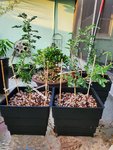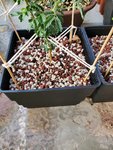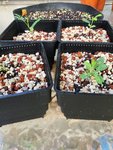abugoogoo
Yamadori
Morning guys n gals,
I have some umbrella thorns that I started from seed about a year ago. I repotted the 3 survivors, along with some new seedlings yesterday. I went with a mix of 50/50 lava and pumice, with some desert sand thrown in, as the reading I've done on these says that they like rocky/sandy alkaline soils. That being said, I'm now rethinking this for several reasons, and I need some advice. 1) the sand is pretty much gone after watering, I guess I used stuff that is too fine and it all washed out. 2) the lava and pumice seem bone dry to me, immediately after watering. All of my other stuff is growing really well in a mix of lava and pumice with some Happy Frog in the mix (I'm in South Florida BTW). This is the first time I've gone 100% inorganic. 3) When I originally transferred these as seedlings into 4 inch pots, I put them in varying amounts of components from almost 100% organic with some volcanic for drainage, to 100% volcanic. The three that survived had significant amounts of the Happy Frog in it, and the one that was doing the absolute best yesterday when I repotted them, in terms of root structure, and the only one that was able to support itself completely upright was probably around 60 to 70% happy frog. I'm thinking about repotting these one more time today with a buncha soil in them, but I wanted to ask for your thoughts first, and if I should do it, or stick it out with what I have now. Ima include some pics for you. You'll excuse the chopsticks and butchers twine, these 2 needed a lot of help standing up.
Also, one more question. If I do stick with what they're in now, how long after repotting should I fertilize? Thanks folks, I appreciate you alot, sorry if these are dumb questions.
I have some umbrella thorns that I started from seed about a year ago. I repotted the 3 survivors, along with some new seedlings yesterday. I went with a mix of 50/50 lava and pumice, with some desert sand thrown in, as the reading I've done on these says that they like rocky/sandy alkaline soils. That being said, I'm now rethinking this for several reasons, and I need some advice. 1) the sand is pretty much gone after watering, I guess I used stuff that is too fine and it all washed out. 2) the lava and pumice seem bone dry to me, immediately after watering. All of my other stuff is growing really well in a mix of lava and pumice with some Happy Frog in the mix (I'm in South Florida BTW). This is the first time I've gone 100% inorganic. 3) When I originally transferred these as seedlings into 4 inch pots, I put them in varying amounts of components from almost 100% organic with some volcanic for drainage, to 100% volcanic. The three that survived had significant amounts of the Happy Frog in it, and the one that was doing the absolute best yesterday when I repotted them, in terms of root structure, and the only one that was able to support itself completely upright was probably around 60 to 70% happy frog. I'm thinking about repotting these one more time today with a buncha soil in them, but I wanted to ask for your thoughts first, and if I should do it, or stick it out with what I have now. Ima include some pics for you. You'll excuse the chopsticks and butchers twine, these 2 needed a lot of help standing up.
Also, one more question. If I do stick with what they're in now, how long after repotting should I fertilize? Thanks folks, I appreciate you alot, sorry if these are dumb questions.



